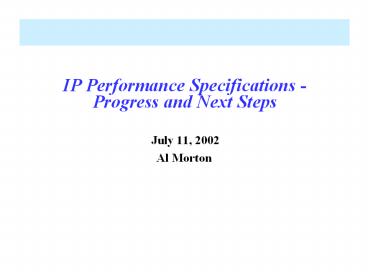IP Performance Specifications - Progress and Next Steps - PowerPoint PPT Presentation
1 / 11
Title:
IP Performance Specifications - Progress and Next Steps
Description:
Al Morton Page 4. Evolution of IPPM and Question 6/13. New RFCs ... Al Morton Page 6 ... Al Morton Page 11. Next Steps. Define Process and Methods to ACHIEVE ... – PowerPoint PPT presentation
Number of Views:16
Avg rating:3.0/5.0
Title: IP Performance Specifications - Progress and Next Steps
1
IP Performance Specifications -Progress and Next
Steps
- July 11, 2002
- Al Morton
2
End-to-End IP Network Performance
- Growth of real-time/CBR application use on IP
nets - VoIP, Multi-Media Conferencing, Streaming...
- New applications require stricter performance
3
IP Packet Transfer Specifications
4
Evolution of IPPM and Question 6/13
- New RFCs
- Loss Patterns
- Bulk Transfer Capacity
- Current I-Ds
- Packet Reordering
- Active Meas. Protocol Req.
- IPPM MIB
- Newly Chartered Work on
- Link Bandwidth Capacity
- Performance Objectives
- Y.1541 (May 2002), six QoS Classes
- Suggest QoS Signaling Support/Methods
- Parameter Revisions
- Y.1540 (Nov 2002)
- other Packet Transfer
- MPLS?
5
Y.1541 "Provisional IP QoS Classes
- Y.1221-based Traffic Contracts
- IP transfer capabilities include the service
model, traffic descriptor, conformance definition
and any QOS commitments. - Transfer Capabilities include Dedicated
Bandwidth, Statistical Bandwidth, and Best
Effort.
6
Viewpoints of QoS
From G.1000, Communications quality of service A
framework and definitions
7
Elements of Service Providers IP QoS View
QoS Framework Std IP Perf Parameters Std IP QoS
Classes SLAs
Objectives Reality
Engineering Implementation
QoS Mechanisms Std Active Meas. Sampling
Methodologies Passive Monitoring
8
QoS Agreements - Today and Tomorrow
Published Req. Design Eng.
Reqmnts. IS Manager
Cooperating Network
Request ACK/REJ/Mod
Objectives Reality
Provisioning QoS Mech. Reports (SLAs)
Users Apps
9
QoS Agreements - Viewed as 3 Entities
Network Published Req. Design Eng.
...
User Requirements
IS Manager/ Requirements
Objectives Reality
Provisioning QoS Mech. Reports (SLAs)
Reports Applications
Perceived QoS
10
QoS Agreements - Future
User
Application
Network(s)
...
Application Requirements Cnfg.Choices
Request ACK/REJ/Mod
Request ACK/REJ/Mod
QoS Requirements
QoS Classes Decisions Topo/Policy Design/Eng.
Objectives Reality
Provisioning QoS Mech. Reports (SLAs)
Feedback Monitoring
Perceived QoS
11
Next Steps
- Define Process and Methods to ACHIEVE e-e
Objectives - Begin with Single networks and Static Agreements
- Static, with Two or Three Networks
- difficult with more networks (see draft M.2301)
- Build-in Flexibility (not too much)
- Network to Network Signaling for QoS
- In the Oracle model, each network has an entity
with specific knowledge and control capabilities.
These entities use a signaling protocol to
communicate efficiently across network boundaries
(accept/reject/modify requests). - Standardize Delay Variation Definitions
- Revisit IP Service Availability Function
Definition - Wide range of sensitivities across user
applications































